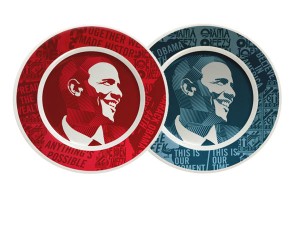 DECONSTRUCTING BARBIE:
DECONSTRUCTING BARBIE:
Loved, hated, analyzed, critiqued — the iconic doll gets repurposed.
This week in Consumed, a jewelry-maker whose raw materials include pieces of Barbie, the consumption icon who turns 50 this year.
Margaux Lange figures she was about 4 or 5 when she got her first Barbie. “I remember very quickly becoming obsessed with collecting as many as I possibly could,” she says. Eventually she had around 50. “I played with them, embarrassingly, until about seventh or eighth grade. In secret.” She’s 29 now and makes jewelry for a living; in her studio, along with her soldering torch and other standard tools of the trade, is a much larger Barbie collection. But these dolls are mostly in pieces, stored in stacked plastic boxes marked with phrases like “One Eye” or “Mouths With Teeth.”
Lange is still playing with Barbie, in a way, but now the dolls are not so much toy companions as elements that she breaks down and incorporates into handmade rings, necklaces, brooches and the like: work made from “sterling silver and Barbie parts,” as she puts it.
Read the column in the January 25, 2009 New York Times Magazine, or here.
Consumed archive is here, and FAQ is here. The Times’ Consumed RSS feed is here. Consumed Facebook page is here.
“Letters should be addressed to Letters to the Editor, Magazine, The New York Times, 620 Eighth Avenue, 6th Floor, New York, N.Y. 10018. The e-mail address is magazine@nytimes.com. All letters should include the writer’s name, address and daytime telephone number. We are unable to acknowledge or return unpublished letters. Letters may be edited for length and clarity.”
AFTER THE JUMP: Some background regarding how this week’s column came about. Only for those who are hard-core curious about the way I think — proceed at your own risk (of being bored).
Read more
Not surprisingly, there is a big sale on all merch at the Bush’s Last Day product site — get your hats, T’s, coffee mugs, and countdown magnets marked 1.20.09 now, so you can … uh… well, so you can have them, I guess. February 10, 2008 column on the brand is here.
Brandweek reports that VitaminWater is being sued by the Center for Science in the Public Interest: “The suit states that the Coke-owned brand is guilty of deceptive and unsubstantiated claims.” An August 22, 2004 Consumed mulled the brand’s over-the-top claims. CSPI’s release about its lawsuit is here.
NYT says mainstream companies are warming up to the idea of sponsoring mixed-martial-arts competitors. August 29, 2008 Consumed on MMA brand TapouT is here.
I don’t have time to look up the links, but shortly after the election I remember a few non-Obama-fan Web commentators suggesting that all the posters and whatnot created by Barackist artists and designers would end up taking on the quality of totalitarian propaganda. I didn’t, and don’t agree (unless the much-awaited stimulus plan includes a government-sponsored proBama postering campaign).
However … the other day, looking at stuff like this with E, it wasn’t hard to imagine another fate for the massive glut of Obamafied artifacts: future kitsch. I think the thrift stores of the future will have shelves and shelves of this stuff.
Possibly that same idea is implied by The Future Perfect’s offering of Obama commemorative plates designed by Shepard Fairey.

Or possibly not. I’m not sure.
Anyway, here’s a painting of Obama, nude, riding a unicorn.
By now somebody must have observed that the Obama economic stimulus plan is clearly premised on (frugal?) consumers buying an absolutely unlimited amount of Obama tchotchkes.
Here is Slate’s slideshow with some examples. Sadly not mentioned: The “Obama Victory Mugs” ($24.95 for a set of two), “Keepsake T-Shirt” ($32.95), and copies of tomorrow’s newspaper (order now!) on offer in the Barack Obama section of the New York Times online store.
In other Obama-culture news, Studio 360 did a segment on Obama art this weekend. April 13, 2008 Consumed on that subject is here. Not enough Obama for you? Link roundup on Obama art and products and marketing here. Search this site for “Obama” for even more.
You and everyone you know are, as always, still invited to contribute images from streets, avenues, boulevards, drives, etc., named for Martin Luther King, Jr.
The Flickr pool is here. The highlights blog is here — and now has images from about 44 cities and towns around the U.S.
Posted Under:
rw
This post was written by Rob Walker on January 19, 2009
Comments (0)
PSFK put up a post about “mutant bike clubs” the other day, and I was annoyed with myself, because I hadn’t taken the time to post a link to some pix taken by friend of Murketing Charles R. Franklin, a New Orleans photographer who was was on hand for a recent gathering of these rather impressive customizers in N.O.
His set of images — worth checking out — is here.
Mr. Franklin also passed along a link to B.I.K.E.: The Movie, in multiple parts on YouTube. Lastly: Here is a 2006 Village Voice article (mentioned here at the time) on the mutant-bike thing — opening with an anecdote about Brooklyn Industries outlets getting defaced with “Bike Culture Not For Sale.” The Black Label Bicycle Club is described as “virulently anti-consumerist.” Making them likely targets for sponsorship offers, I assume.

Posted Under:
DIYism
This post was written by Rob Walker on January 19, 2009
Comments Off on Bikers
That’s the only conclusion I can draw from yesterday’s NYT story about apparently healthy banks who got chunks of cash from TARP and now amiably admit that they’re simply sitting on it.
One guy actually refers to the $88 million his bank received from Treasury as “opportunity capital.” (After all, “They didn’t tell me I had to do anything particular with it,” he said.)
“We see TARP as an insurance policy,” agrees the head of a bank that got $300 million in “bailout” money. “That when all this stuff is finally over, no matter how bad it gets, we’re going to be one of the remaining banks.”
Great.
I’ve toyed with both LastFM and Pandora. I have not used iLike or MOG, which like LastFm seem to turn on a more “social”-oriented idea.
Do you have opinions about these networks/services — or others?
Please chime in, in the comments, if you do.
Thanks.
PS: No Consumed this weekend.
Posted Under:
Music
This post was written by Rob Walker on January 17, 2009
Comments (4)
Let’s say that right after I post this item, I keel over, dead.
Who would approve whatever pithy comments you might submit? Aside from this site, I have two other unrelated blogs, a Facebook profile and page, a Flickr account, a personal website, an Etsy store, etc. What happens to all that stuff?
I know that there are policies in place at the companies that ultimately control my digital expressions of my (living) self — I just read this NYT column in which the writer relates some the death-related policies of Facebook, which she looked into after being notified of the pending birthday of a deceased friend.
But the column made me wonder what the dead friend would have wanted. And how I would want my digital afterlife to be handled: What should disappear along with me, what I would prefer to persist and with what adjustments and caveats.
Morbid! But still. Maybe such a business already exists, but if it doesn’t: Perhaps one of the bright, young business-school things who read this site can found a digital-afterlife-management service.
The product/service would be sort of analogous to a will. It would store and manage all the necessary passwords for one’s appointed digital-life executor, but would also spell out the wishes, preferences, and instructions of the relevant individual: Wipe out X account; put up an announcement on Y blog and close the comments; renew the domain registration on Z site for as long as possible, etc. Unlike a traditional will, this would have to be some kind of regularly updatable service, to keep pace with the digital venues, as they come and they go.
At the very least, I’d like to know, for the sake of accuracy, that somebody would be making sure my Twitter feed finally showed a second tweet.

Wish I could find more images online from this book: “Off The Wall: Political Posters of the Lebanese Civil War.”
The Economist says:
IF THE devil has the best tunes, radicals make the best posters. In Lebanon the propaganda posters of Hizbullah and its allies are a heady mix of bright colour, simple logos and distinctively Arab calligraphy and portraits. The government commissioned Saatchi & Saatchi to make its case in 2006, but its advertising was never as striking as the humblest political placard from the Islamists.
The poster collection in “Off the Wall”, comes from the 20-odd factions of Lebanon’s 1975-90 civil war and shows that the shifting alliance of leftists and other radicals had artistic flair from the outset. Hizbullah, the Communists, the Syrian nationalists and the PLO, among others, harnessed contemporary graphic design and made it their own: Jerusalem in glowing colours features alongside clenched fists and AK-47s; the four-sided Syrian symbol rises like a sun; car bombs go bang like Roy Lichtenstein paintings.

Quite possibly the humor/photo blog Crummy Church Signs — “Critical analysis of critically bad church signs” — has been highlighted by Boing Boing or some similar site. But this example, via Ffffound, seemed worth sharing just the same.
Posted Under:
Just Looking
This post was written by Rob Walker on January 14, 2009
Comments Off on Just Looking
 Earlier I mentioned an offer to college classes — basically to do classroom “visits” via video Skype — and I’m pleased to say that four such visits are on the schedule for this semester, at fine schools from coast to coast. I could still do one more in either March* or May, if anyone is interested. Details and contact here.
Earlier I mentioned an offer to college classes — basically to do classroom “visits” via video Skype — and I’m pleased to say that four such visits are on the schedule for this semester, at fine schools from coast to coast. I could still do one more in either March* or May, if anyone is interested. Details and contact here.
On the other hand, a sort of similar offer to book clubs has had fewer takers. A couple of inquiries, but nothing that ever got nailed down. That’s too bad, I think Buying In is a great book to talk about right now if you happen to be interested in changing the way you shop. (I may be biased in my opinion on that.) But I reiterate the offer, and again could do something in either March or May. Details and contact here.
That is all.
[1/20: March now booked.]
The other day I read something in The New Republic, a book review in which the writer said in passing: “The media industry’s attacks on the net can be scary, but they can also be understood as death throes.”
I had to read that sentence again. What was he talking about? Not the death throes — I get that part. The scary attacks. I realized he must be referring to the occasional high-minded broadsides about blogs dumbing down the culture, or whatever. I’ve seen those. But does anybody really find them “scary”? Surely nobody in the new-media blogosphere does. Such laments have approximately zero impact, and are routinely swatted down by the blognoscenti as, yes, the death throes of irrelevant gatekeeper dinosaurs who don’t get it and don’t matter anymore. “Dead tree media” and all that.
The next day I was skimming an issue of New York Magazine and noticed this exchange in a Q&A with Rob Corddry about his new Web-only show, Children’s Hospital.
Q: How do you market a Web show?
A: I had my publicist get me an interview at New York Magazine.
Q: Seriously.
Corddry goes on to say something vague about “manipulating Google,” but the right answer is: “Um, seriously. Who the fuck are you kidding? Mainstream media eats up news of the latest new-media whatever with a spoon!”
After all, isn’t that the case? Occasional broadsides notwithstanding, hasn’t the traditional media, by and large, functioned largely as a cheerleader for and amplifier of new media? If Corddry has a traditional sitcom, nobody (in the mainstream media) really cares. But he has a Web-based sitcom? Oooh! Cutting-edge! Write it up!
The Times Magazine (my primary client, of course) has done more than one cover story about bloggers, and has hired one of the most talented critics I’ve ever met to do a column about aspects of Web-media culture every week. The column is not a series of scary attacks. Meanwhile, every section of the paper has done multiple stories about this or that blogger in almost every category imaginable — design, gossip, restaurants, politics, “citizen journalists,” whatever. I would certainly guess the paper has run more stories about Twitter than about, say, a TV show like N.C.I.S., which probably has at least double the audience.
But this makes sense, in that the new-media stories are, you know, newer. More like news. Indeed I would actually say that one meta-story that the traditional media has covered quite thoroughly in the last 10 or 15 years is the story of the new media. Has there ever been a significant online phenomenon that was not only covered but in effect abetted by mainstream coverage? That is to say: I wonder how often new-media properties, from Napster to Facebook, take off precisely because old media introduced them to a wider audience. Or at the very least, if the old-media coverage didn’t juice things along much faster than might have otherwise occurred.
I’m not suggesting that new-media forms wouldn’t catch on anyway. But I am suggesting that the number of “scary attacks” from the old media are far outweighed by “ya gotta check this out” hype. Which is exactly why Corrdry’s new-media strategy involved having his publicist call New York Magazine.
An amusing Talk of the Town piece by Ben McGrath in this week’s New Yorker puts Drank (Consumed: December 31, 2008) to a taste test of sorts — and suggests that an “anti energy drink” may be particularly in sync with a jittery cultural moment. (By the way, I happen to have very reliable information that this piece was actuallly written before my Drank column appeared, so I’m not suggesting they’re following or getting ideas from me; indeed I’m never suggesting that with these updates.)
I must admit that when I wrote about the Buddha Machine (Consumed: July 29, 2007), it had already gotten enough attention that I figured I would basically be the last person to do so. But since its creators keep coming up with new iterations and spins on the device, and people keep discovering it, it has proven remarkably resilient. Here is Sasha Frere-Jones’ brief Q&A with Buddha Machine co-creator Christiaan Viant.
 On a similar note, Uglydolls (Consumed: February 15, 2004) have gotten a fresh wave of press because Sasha Obama has one.
On a similar note, Uglydolls (Consumed: February 15, 2004) have gotten a fresh wave of press because Sasha Obama has one.
The Newark Star-Ledger says: “As Seen on TV! Pitchmen Reign During Hard Times.” The creator of the PedEgg asserts: “In bad economic times, our business gets better.”Also in the piece is Billy Mays, subject of October 24, 2008 Consumed.
The new (forthcoming) Palm Pre phone is getting lots of attention, and I’ve read assessments both positive and not-so-much. Here’s the FT writeup: “Palm, a former icon of technology that was largely given up for dead by Wall Street, has emerged as an unlikely star from this week’s annual Consumer Electronics Show with a new product that many tech analysts are already comparing with Apple’s iPhone.” Remember when the Treo was cutting edge? Well: Consumed January 25, 2004.
Posted Under:
Update
This post was written by Rob Walker on January 12, 2009
Comments Off on Dept. of update: Drank, Billy Mays, Uglydolls, etc.
 DECONSTRUCTING BARBIE:
DECONSTRUCTING BARBIE:



 "
"



















 Kim Fellner's book
Kim Fellner's book  A
A